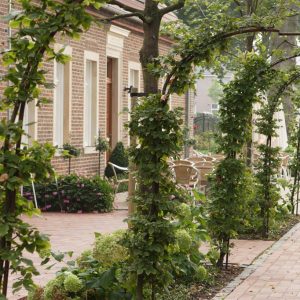Glass depot Höltingshof
In spring 2006, Kurt (1929-2011) and Lilly Ernsting opened the glass depot in Coesfeld-Lette. Since then visitors have had the opportunity to see the complete glass collection. Looking at the German museum landscape, the glass depot is still extraordinary and unique.
The collection of outstanding works of glass art has grown enormously over the museum’s past decades. To date, the collection counts über 2.000 works. All techniques are represented, as well as both applied art objects and autonomous pieces, miniatures and monumental works, and artists from throughout Europe and lands farther afield. As a rule, museum storage rooms are not open to the public. The objects in a collection are usually kept hidden away in a basement or other storage space. The public then only sees what the museum deliberately puts on display.
But Lilly Ernsting (1930-2023) had other plans. She wanted to share with others the joy collecting has brought her and the pleasure she takes in studying the works again and again. So she resolved together with her husband to set up a Glass Depot, a study collection. It would take years, however, before their wish would be fulfilled.
The Ernstings had their eye on the neighbouring Höltingshof, a former farmstead from the 19th century, which had been run in recent decades by the Roman Catholic Diocese of Münster as a holiday home for children and young people. The buildings were in dilapidated condition, the building facilities outdated, and the ensemble was lacking in charm. The Ernstings planned to change all of this and to adapt the complex for use as an exhibition space for the glass collection. Parts of the buildings were torn down, the threshing floor was sunk by 50 cm to incorporate a gallery, the garden was redesigned, and the former farmhouse was converted into a café. All in all, without forfeiting the original external architecture, the ensemble experienced a new beginning.
The visitor now encounters there two levels lined with large glass display cases designed especially to accommodate the glass objects. The display cases are arranged in a systematic chronological sequence. With labels and lists, they inform visitors of the origins of the collection and provide details on how it evolved within the context of the history of glass art. Since 2006, newly acquired glass objects have found a home in the Glass Depot. Occasionally, they migrate to the Glass Museum, where they are staged in exhibitions, as opposed to their functional display at the Glass Depot.
Lilly Ernsting’s avid collecting activities resulted in the conversion of the barn next to the Glass Museum at the Alter Hof Herding opposite into another storage depot for glass art in 2012. In identical display cases, the objects from the years 1970 to 2003 are on view there, while objects purchased in 2004 or later are displayed at the Glass Depot in the Höltingshof. This separation of the collection into two sections has created potential space for numerous new works.







